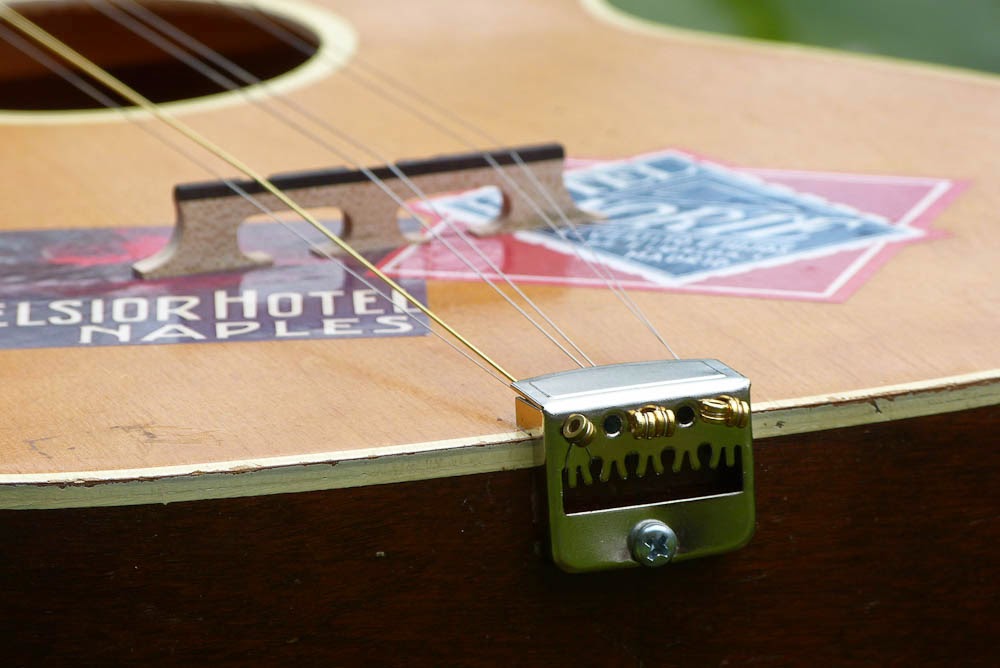c.1955/2014 Cuban Tres Conversion
This little fella (it's approximately the size of a terz guitar with a 22 3/8" scale length) started life as something roughly similar to a US Strad style guitar but a bit smaller. It's got an all-laminate birch body with ladder bracing and a chunky 1 11/16" nut-width neck made of poplar (I believe). The short scale and build with its original classical-style bridge installed had just an awful tone as a guitar. I expected that: low tension, body too small for adequate bass, big bridge eating up a lot of the soundboard... typical 50s/60s student or kid's guitar mess.
So: why not have fun? I yanked that bridge off, covered up the light-colored unfinished bit under the bridge with some old-fashioned travel stickers, bolted the neck back to true, leveled and dressed the frets... and then converted it into a 3-course Cuban tres! Lucky for us, the specs of this instrument are pretty close to those of an actual tres in size and scale and the wider neck for 3 courses is traditional for these instruments. It's a win-win... because this thing is loud, saucy, playing spot-on (1/16" action at the 12th fret) and fun in this configuration where it was stifled and boring before.
I reused the original nut by shaving it down and reslotting it.
I also added clay-style side dots a 5, 7 and 9 to give this a bit of position marking. The frets are brass, comfy, and the board appears to be something like a cheapish version of rosewood. It feels surprisingly-good on the fingers.
The wide string spacing is traditional on the Cuban tres and allows for all sorts of fingering options and half-chords as you go up the neck. Traditionally the instrument is tuned GCE low to high in the same range as a guitar's GBE strings. The C&E strings are usually in unison while the lowest course has an octave string. The octaved low string and high-end chime is what gives this instrument its particular sound. You could theoretically string something like this up on a uke-sized instrument and have it sound decent but you wouldn't get the surreal extra volume or swooning, biting sustain that the bigger body and long scale supply.
I've strung it with gauges roughly alike to standard tres strings and they've gotten me into a variety of tunings I find more practical to my own mind: I've kept it tuned to a modal E chord: EBE. You can also tune up from this same modal chord a half-step to FCF (open F) or open G (GDG) for different tonal effects. Once there you can just capo it up and down for different keys. In this capacity it's actually more like a trichordio bouzouki (3 course Greek bouzouki which is strung the same way but tuned to D) but you get more of that saucy Latin-sounding bite with the way the instrument is setup.
To mute the top as little as possible I used a 3-foot banjo bridge which I've compensated so you play in tune up the neck. This works so, so, so much better than the big old honking glued bridge this originally came with.
Because it's laminate there are no cracks but there are plenty of scuffs, scratches and small dings here and there all over.
The tuners this came with were replacements anyhow and installed poorly so I scrounged these hilariously-buttoned tuners from my parts bin. I tend to pull these tuners off of Chicago-made stduent instruments that have had them retrofitted because they look totally silly on them. In this instance, where I'm attempting to ape an instrument that might've had similar buttons in the first place, they work perfectly. They're not fancy but they get the job done.
The neck joint was, of course, loose. I removed some odd shim material someone had shoved in the heel (strangely enough, to tilt the neck forward -- doh!) and then drilled-out and bolted the thing with access to tensioning-up at the neck block. I would've strap-buttoned it at the same time but I seem to be out of the type I like to use for this work...!
The "binding" is, of course, painted-on.
My tailpiece solution is actually pretty close to the mini tails that I've seen on other tres examples. In this case I used a parts-bin "model A" banjo tail and just screwed it to the side like a mandolin tailpiece. This accepts loop or ball-end strings of which I've used both and doubled up in stringing holes 1, 3, and 5.














Comments
Dan